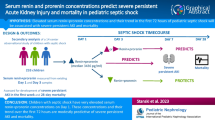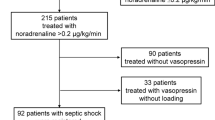Abstract
Objective
To investigate the increase in plasma cyclic GMP (cGMP) concentrations in humans with hyperkinetic septic shock (SS) and to evaluate its relationship to low systemic vascular resistance (SVR).
Design
Prospective clinical investigation.
Setting
Medical intensive care unit of a university hospital.
Patients
22 patients with documented SS requiring hemodynamic resuscitation, respiratory support and —in some cases — hemodialysis.
Measurements and results
Hemodynamic data were recorded at admission time and then twice a-day during the following 72 h. We simultaneously measured cyclic GMP, atrial natriuretic peptides (ANP), creatininemia and platelet counts. At admission time, higher plasma cGMP concentrations were observed in patients with SS (11.84±1.52 pmol·ml−1) than in healthy controls (1.77±0.18 pmol·ml−1,p<0.0001), in septicemia patients without circulatory failure (3.28±0.36 pmol·ml−1,p<0.005) or in patients with hyperkinetic non-septic shock (3.6±0.7 pmol·ml−1,p<0.02). In contrast, there was no significant difference between patients with SS and controls with anuria from non-septic origin. Also ANP concentrations were higher in patients with SS than in others. In addition, cGMP levels correlated negatively with SVR during the first 48 h of the study, and positively with creatininemia later when renal function worsened. However, they did not correlate significantly with ANP.
Conclusion
These data demonstrate that a significant increase in plasma cGMP concentrations occurs during human SS and that it correlates with the decline in peripheral vascular resistance in the absence, but not in the presence, of severe renal failure. Furthermore, the increase in cGMP levels cannot be ascribed solely to enhanced ANP-induced particulate guanylyl cyclase activity. Thus, our results suggest the occurrence of another endogenous source of cGMP during hyperkinetic SS.
Similar content being viewed by others
References
Paratt JR (1989) Alterations in vascular reactivity in sepsis and endotoxemia. In: Vincent JL (ed) Update in intensive care and emergency medicine. Springer, Berlin Heidelberg New York Tokyo, pp 299–308
Tedgui A, Bernard C (1991) Interactions between cytokines and vascular wall: effect on the contractile function. In: Vincent JL (ed) Update in intensive care and emergency medicine. Springer, Berlin Heidelberg New York Tokyo, pp 213–222
Palmer RMJ, Ferridje AG, Moncada S (1987) Nitric oxide release accounts for the biological activity of endothelium-derived relaxing factor. Nature (London) 327:524–526
Julou-Schaeffer G, Gray GA, Fleming I et al (1990) Loss of vascular responsiveness induced by endotoxin involves the L-arginine pathway. Am J Physiol 259:H 1038-H 1043
Knowles RG, Merett M, Salter M et al (1990) Differential induction of brain, lung and liver nitric oxide synthase by endotoxin in the rat. Biochem J 270:833–836
Debbie B (1990) Interleukin 1 and endotoxin activate soluble guanylate cyclase in vascular smooth muscle. Am J Physiol 259:R38-R44
Lonchampt MO, Auguet M, Delafotte S et al (1992) Lipoteichoic acid: a new inducer of NO synthase. In: Proceedings of the Second International Symposium on Endothelium-Derived Vasoactive Factors, Basel (Abstract)
Busse R, Kaufmann H, Mulsch A (1991) Inducible NO synthase in the human vasculature. In: Proceedings of the Second Conference on Nitric Oxide, London (Abstract)
Schulz S, Yven PST, Garbers DL (1991) The expanding family of guanylyl cyclases. TIPS 12:116–120
Arnold WP, Mittal CK, Katsuki S et al (1977) Nitric oxide activates guanylate cyclase and increases guanosine 3′5′ cyclic monophosphate levels in various tissue preparations. Proc Natl Acad Sci USA 74:3203–3207
Schini V, Schoeffter P, Miller RC (1989) Effect of endothelium on basal and on stimulated accumulation and efflux of cyclic GMP in rat isolated aorta. Br J Pharmacol 97:853–865
Huntsman LL, Steward DK, Barnes SR et al (1983) Non-invasive Doppler determination of cardiac output in man: clinical validation. Circulation 67:593–602
Meyer RA, Kalavathy A, Korfhagen JC, Kaplan S (1982) Limitations of Doppler echocardiography in the calculation of cardiac output. Circulation 66 [Suppl 2]:122
Schuller F, Fleming I, Stoclet JC et al (1992) Plasmatic cyclic GMP is not a direct index of L-arginine/nitric oxide pathway activation by endotoxin. Eur J Pharmacol 212:93–96
Hamet P, Tremblay J, Genest M et al (1984) Effect of native and synthetic ANF on cyclic GMP. Biochem Biophys Res Commun 123:515–527
Münzel T, Drexler H, Holtz J, Kurtz S, Just H (1991) Mechanisms involved in the response to prolonged infusion of atrial natriuretic factor in patients with chronic heart failure. Circulation 33:191–201
Vorderwinkler KP, Artner-Dworzak E, Jakobs G et al (1991) Release of cyclic guanosine monophosphate evaluated as a diagnostic tool in cardiac diseases. Clin Chem 37:168–190
Waldman SA, Rapoport RM, Murad F (1984) ANF selectively activates particulate guanylate cyclase and elevates cyclic GMP in rat tissues. J Biol Chem 259:14332–14334
Shirasaki S (1986) Effect of endotoxin shock on plasma levels of immunoreactive atrial natriuretic polypeptide and stress hormones in dogs. Masui 35:1650–1655
Kelm M, Feelisch M, Deussen A et al (1991) Release of endothelium derived nitric oxide in relation to pressure and flow. Cardiovasc Res 25:831–836
Lowe DW, Chang MS, Goeddel DV et al (1989) Human ANF receptor defines a new paradigm for second messenger transduction. EMBO J 8:1377–1384
Field M, Graf LH, Laird WJ et al (1978) Heat stable enterotoxin ofE. coli: in vitro effects on guanylate cyclase activity, cGMP concentration and ion transport in small intestine. Proc Natl Acad Sci USA 75:2800–2804
Katsuki S, Arnold W, Mittel C et al (1977) Stimulation of guanylate cyclase by sodium nitroprussiate, nitroglycerol and nitric oxide in various tissue preparations and comparison to the effect of sodium azide and hydroxylysine. J Cyclic Nucleotide Res 3:23–25
Moncada S, Palmer RMJ, Higgs EA (1991) Nitric oxide: physiology, pathophysiology and pharmacology. Pharmacol Rev 43:109–142
Roy LF, Ogilvie RI, Larochelle P et al (1989) Cardiac and vascular effects of atrial natriuretic factor and sodium nitroprusside in healthy men. Circulation 79:383–392
Schneider F, Lutun P, Hasselmann M, Stoclet JC, Tempé JD (1992) Methylene blue increases systemic vascular resistance in human septic shock. Intensive Care Med 18:309–311
Author information
Authors and Affiliations
Rights and permissions
About this article
Cite this article
Schneider, F., Lutun, P., Couchot, A. et al. Plasma cyclic guanosine 3′–5′ monophosphate concentrations and low vascular resistance in human septic shock. Intensive Care Med 19, 99–104 (1993). https://doi.org/10.1007/BF01708370
Received:
Accepted:
Issue Date:
DOI: https://doi.org/10.1007/BF01708370




